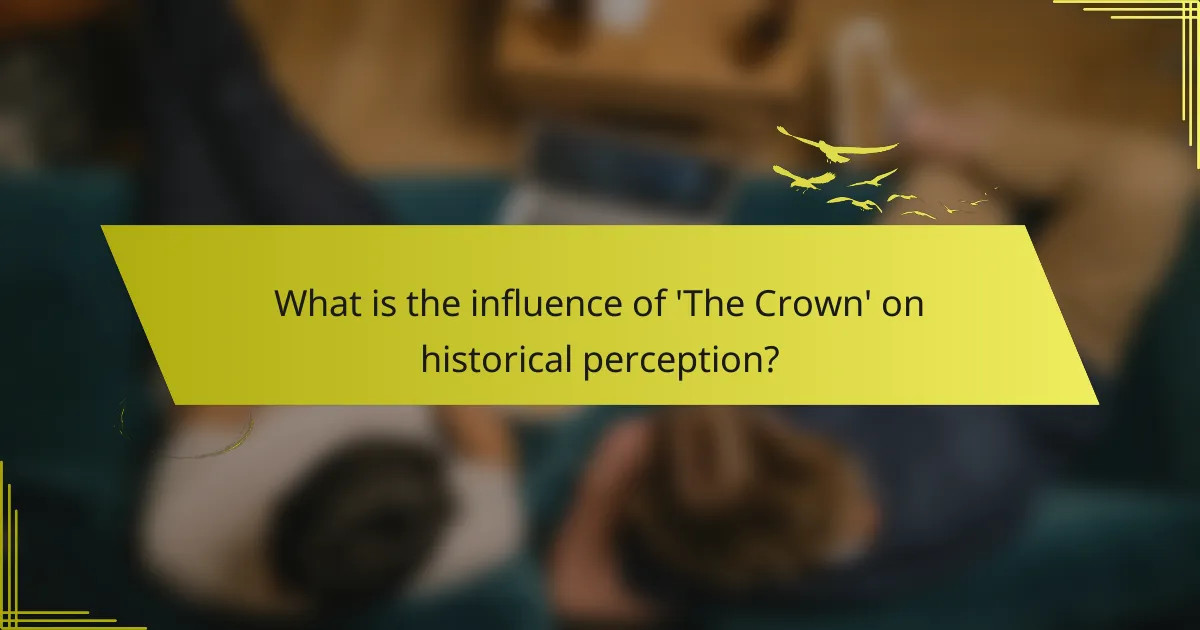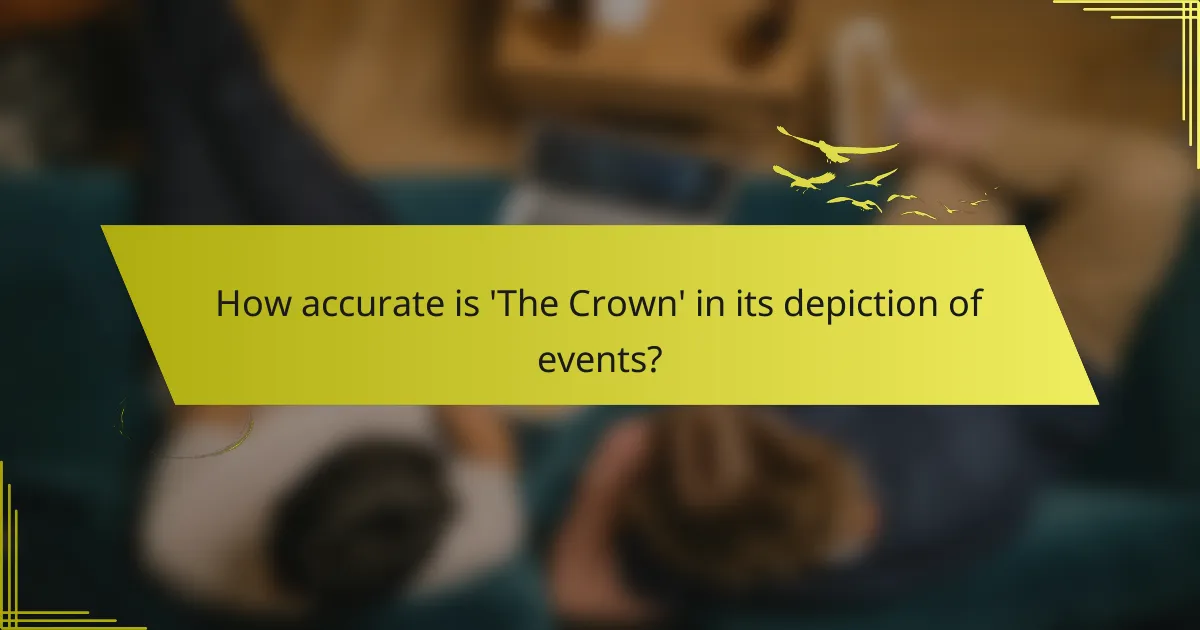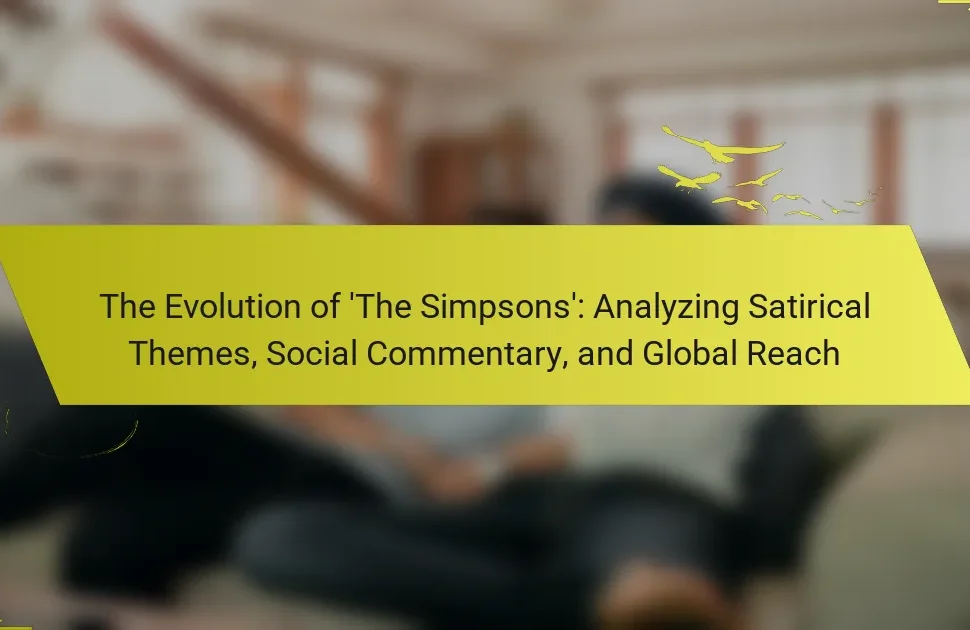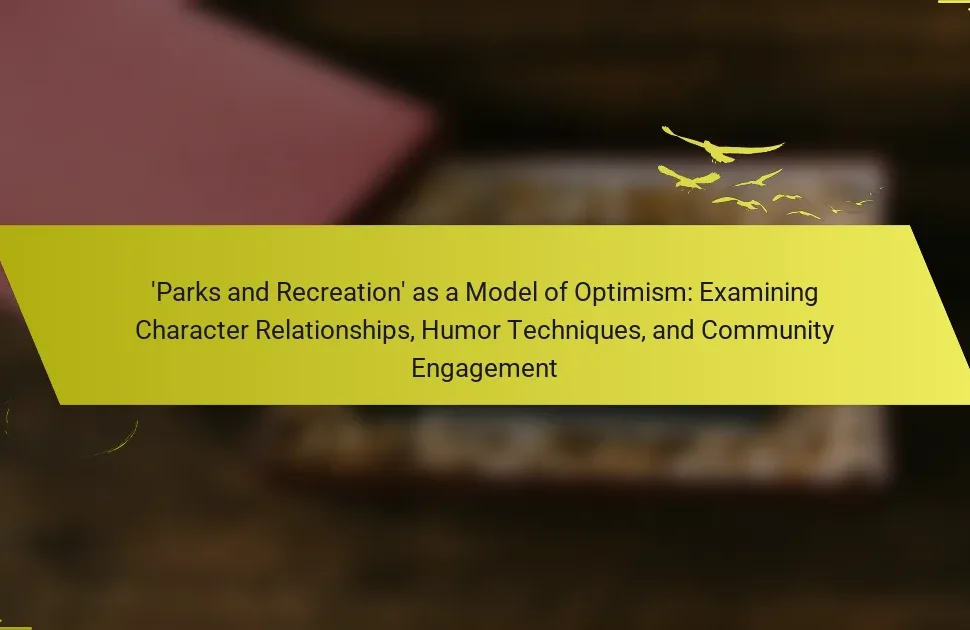‘The Crown’ is a dramatized television series that significantly influences public perception of British history by portraying key historical events and figures. The series presents characters such as Queen Elizabeth II, Prince Philip, Winston Churchill, Princess Diana, and Margaret Thatcher with emotional depth, which can blur the lines between fact and fiction in viewers’ memories. Academic studies indicate that such dramatizations can alter perceptions of historical accuracy while simultaneously increasing interest in real historical events. Although ‘The Crown’ captures significant moments in history, it often takes creative liberties, leading to discussions about the monarchy’s legacy and the nature of historical representation in media.

What is the influence of ‘The Crown’ on historical perception?
‘The Crown’ significantly influences historical perception by dramatizing key events and figures in British history. The series presents a narrative that shapes viewers’ understanding of the monarchy and political events. Characters are portrayed with emotional depth, making historical figures relatable. This portrayal can lead to a blend of fact and fiction in public memory. Academic studies, such as those by the Historical Association, indicate that dramatizations can alter perceptions of historical accuracy. Additionally, viewer engagement with the series often leads to increased interest in real historical events. The influence of ‘The Crown’ thus extends beyond entertainment, affecting educational contexts and public discourse on history.
How does ‘The Crown’ portray historical figures?
‘The Crown’ portrays historical figures through dramatized interpretations that blend fact with artistic license. The series emphasizes personal relationships and political dynamics within the British royal family. For instance, Queen Elizabeth II is depicted as a complex character navigating duty and personal sacrifice. Winston Churchill is shown as a pivotal figure, illustrating his leadership during challenging times. The show often highlights private moments, providing insight into the emotional lives of these figures. Critics have noted that while the series captures the essence of historical events, it occasionally prioritizes narrative over strict accuracy. This approach influences public perception, often leading viewers to form opinions based on dramatized portrayals rather than historical facts.
What character traits are emphasized in the portrayals?
The character traits emphasized in the portrayals of ‘The Crown’ include resilience, duty, and vulnerability. Resilience is depicted through the characters’ ability to navigate personal and political challenges. Duty is highlighted in their commitment to the monarchy and public service. Vulnerability is shown in moments of personal struggle and emotional conflict. These traits contribute to a nuanced understanding of historical figures. For example, Queen Elizabeth II’s portrayal often emphasizes her sense of duty amidst personal loss. This focus on character traits shapes public perception of the monarchy’s complexities.
How do these portrayals align or conflict with historical accounts?
Portrayals in “The Crown” often conflict with historical accounts. The series dramatizes events for narrative effect, leading to inaccuracies. For example, the depiction of Queen Elizabeth II’s early reign suggests a more personal conflict with Winston Churchill than historical evidence supports. Historical records indicate Churchill and Elizabeth maintained a professional relationship. Additionally, the show presents fictionalized dialogues and scenarios that did not occur. Such creative liberties can mislead viewers about the actual dynamics of the monarchy. Overall, while some elements reflect real events, many portrayals diverge significantly from documented history.
What role does accuracy play in ‘The Crown’?
Accuracy in ‘The Crown’ shapes viewers’ understanding of historical events and figures. The series presents dramatized portrayals of real-life individuals, particularly members of the British royal family. This dramatization balances entertainment with historical fidelity. Critics often highlight inaccuracies that may mislead audiences about the true nature of events. For instance, certain dialogues and confrontations are fictionalized for dramatic effect. Despite this, the show has sparked public interest in British history. The blend of fact and fiction prompts discussions about the monarchy’s role in contemporary society. Overall, accuracy influences both the show’s credibility and its impact on historical perception.
How does the series balance dramatization and historical fact?
The series balances dramatization and historical fact by intertwining fictional narratives with real historical events. It uses actual timelines and significant occurrences as a backdrop. Key figures are portrayed with a blend of documented actions and imagined personal motivations. This approach allows for dramatic storytelling while maintaining a connection to history. For example, major events like the Suez Crisis are depicted with attention to their historical significance. The series also incorporates real speeches and public reactions to enhance authenticity. Critics note that while some scenes are fictionalized, they reflect the broader truths of the era. The creators aim to spark interest in the historical context among viewers.
What are the implications of inaccuracies for viewers’ understanding of history?
Inaccuracies in historical portrayals can significantly distort viewers’ understanding of history. When viewers consume content with inaccuracies, they may form misconceptions about key events and figures. This can lead to a skewed perception of historical timelines and contexts. For example, dramatizations may exaggerate or simplify complex relationships, impacting the audience’s grasp of political dynamics. Such inaccuracies can also perpetuate stereotypes and myths about certain historical figures or groups. Research shows that viewers often struggle to differentiate between dramatized content and factual history. Consequently, inaccuracies can undermine public discourse and critical thinking regarding historical events. Overall, the implications of inaccuracies can lead to a less informed public and a misrepresentation of historical truths.
How has public reception shaped the perception of historical events?
Public reception significantly shapes the perception of historical events. This occurs through collective memory, which is influenced by media portrayals. For example, the portrayal of Queen Elizabeth II in ‘The Crown’ impacts how audiences view her reign. Positive reception can lead to a more favorable interpretation of events. Conversely, negative reception may result in a critical view of historical figures. Research indicates that dramatizations can alter public understanding of history. A study from the University of Kent found that viewers often conflate dramatized narratives with factual history. This demonstrates the powerful role public reception plays in shaping historical perception.
What are the critical responses to ‘The Crown’ from historians?
Historians have provided mixed critical responses to ‘The Crown.’ Some praise its production quality and attention to detail. They argue that it offers a compelling narrative of the British monarchy. Others criticize its historical inaccuracies and dramatization of events. Some historians believe it blurs the line between fact and fiction. They argue this can mislead viewers about historical realities. Notably, historian Andrew Roberts has expressed concern over the series’ portrayal of certain figures. He emphasized the importance of accuracy in historical representation. Overall, critical responses highlight both the show’s artistic merit and its potential impact on public perception of history.
How does audience perception influence the series’ narrative choices?
Audience perception significantly influences the narrative choices in series like ‘The Crown.’ The creators often adjust storylines to align with viewer expectations and sentiments. This responsiveness can lead to character portrayals that resonate with contemporary audiences. For instance, historical accuracy may be sacrificed for dramatic effect if it enhances viewer engagement. Audience feedback can also prompt changes in character arcs or plot developments in subsequent seasons. The impact of social media amplifies this effect, as viewer reactions are immediate and widespread. Ultimately, the series aims to balance artistic expression with audience satisfaction to maintain viewership and relevance.
What connections exist between ‘The Crown’ and modern political discourse?
‘The Crown’ influences modern political discourse by shaping public perceptions of the monarchy and political figures. The series dramatizes historical events, prompting discussions on leadership and governance. It presents the British royal family in a contemporary context, influencing how audiences view their relevance today. The portrayal of political tensions, such as those between the monarchy and government officials, mirrors current political divides. This connection fosters dialogue about accountability, tradition, and modernity in governance. Viewers often relate the show’s themes to current political events, enhancing its impact on public opinion. The series has sparked debates about the role of the monarchy in democracy, reflecting broader societal concerns.
How does ‘The Crown’ impact the legacy of the British monarchy?
‘The Crown’ influences the legacy of the British monarchy by shaping public perception and historical understanding. The series dramatizes key events and figures, offering a narrative that blends fact with fiction. This portrayal can humanize royal figures, making them more relatable to the audience. It also prompts discussions about the monarchy’s relevance in modern society. Viewers may form opinions based on the dramatized events, affecting their perception of the monarchy’s role. Academic studies, such as those from the Journal of Popular Culture, highlight how media representations shape historical narratives. Consequently, ‘The Crown’ can alter the legacy of the British monarchy by influencing how history is remembered and interpreted.

What are the character portrayals in ‘The Crown’?
The character portrayals in ‘The Crown’ depict real historical figures with depth and complexity. Queen Elizabeth II is shown as a determined and often conflicted leader. Prince Philip is portrayed as a supportive yet sometimes rebellious consort. Winston Churchill is depicted as a strong yet flawed statesman, highlighting his leadership during wartime. Princess Diana is presented as a compassionate figure facing immense public scrutiny. Margaret Thatcher is illustrated as a formidable politician with a controversial legacy. Each character’s portrayal reflects their historical context and personal struggles. The series blends fact and dramatization to engage viewers while sparking discussions on historical accuracy.
Who are the key historical figures depicted in the series?
The key historical figures depicted in the series “The Crown” include Queen Elizabeth II, Winston Churchill, and Princess Diana. Queen Elizabeth II serves as the central character throughout the series, showcasing her reign and personal challenges. Winston Churchill is portrayed during his time as Prime Minister, particularly during World War II. Princess Diana’s character explores her life and struggles within the royal family. Other notable figures include Prince Philip, Margaret Thatcher, and various members of the British royal family. Each character is depicted with a focus on their historical significance and personal narratives. The series aims to provide a nuanced view of their lives and decisions.
What are the unique attributes of each character portrayal?
The unique attributes of each character portrayal in “The Crown” include distinct personality traits, historical accuracy, and emotional depth. Queen Elizabeth II is depicted as resilient and duty-bound, showcasing her commitment to the monarchy. Prince Philip is portrayed as complex and often conflicted, highlighting his struggles with royal expectations. Winston Churchill is characterized as stubborn yet charismatic, reflecting his leadership style during tumultuous times. Princess Diana is shown as compassionate and vulnerable, illustrating her impact on the royal family and public perception. Margaret Thatcher is depicted as determined and politically astute, emphasizing her role as a pioneering female leader. Each portrayal is grounded in historical context, enhancing the narrative’s authenticity. These attributes contribute to the series’ overall influence on public understanding of these historical figures.
How do the character arcs reflect historical events?
Character arcs in ‘The Crown’ reflect historical events by illustrating the personal and political struggles of key figures. These arcs depict the impact of significant events on their development. For example, Queen Elizabeth II’s character evolves in response to the changing political landscape of the UK. Her decisions mirror real historical dilemmas faced during her reign, such as the Suez Crisis and the decolonization of Africa. Prince Charles’s arc reflects the challenges of modernizing the monarchy amidst public scrutiny. His experiences parallel societal shifts in attitudes towards the royal family. Each character’s journey is intertwined with actual historical milestones, showcasing how personal choices influence broader historical narratives. This alignment enhances viewers’ understanding of the complexities surrounding these historical figures.
What are the common themes in the character portrayals?
Common themes in character portrayals in “The Crown” include duty, sacrifice, and personal conflict. Characters often struggle between personal desires and their responsibilities to the crown. The theme of loyalty is prevalent, showcasing the tension between familial bonds and public expectations. Additionally, the portrayal of mental health issues highlights the emotional toll of royal life. Power dynamics within the monarchy reveal the complexities of relationships among characters. Historical context is essential, as it shapes the characters’ motivations and actions. The series also emphasizes the impact of public opinion on personal decisions. These themes resonate with audiences, contributing to the show’s critical acclaim and cultural discussions.
How do personal struggles relate to broader historical contexts?
Personal struggles often reflect and are influenced by broader historical contexts. Individual experiences are shaped by the societal, political, and economic conditions of their time. For instance, during the Great Depression, personal financial hardships were widespread, mirroring the economic crisis. Similarly, the civil rights movement highlighted personal struggles against systemic racism, showcasing the fight for equality. Historical events can amplify personal challenges, as seen in wartime experiences that affect mental health and family dynamics. The portrayal of these struggles in media, such as “The Crown,” can enhance public understanding of historical events. This connection between personal and historical narratives allows for a more nuanced view of history.
What role does gender play in the character portrayals?
Gender significantly influences character portrayals in “The Crown.” Female characters often embody traditional roles, reflecting societal expectations. For example, Queen Elizabeth II is depicted as a strong yet constrained leader. Male characters, such as Winston Churchill, are portrayed with more agency and assertiveness. This contrast highlights gender dynamics in leadership. The series illustrates how gender shapes narratives and character arcs. Historical accuracy is sometimes adjusted to fit these portrayals. The portrayal of gender roles can affect audience perceptions of historical figures.

How accurate is ‘The Crown’ in its depiction of events?
‘The Crown’ is a dramatized portrayal of historical events, blending fact with fiction. While it captures significant moments in British history, it often takes creative liberties. For instance, certain dialogues and interactions are fictionalized for dramatic effect. Historical accuracy varies across seasons, with some events depicted more faithfully than others. Critics have noted discrepancies in character motivations and timelines. Experts suggest that while it raises awareness of historical issues, it should not be viewed as a documentary. The series has sparked discussions about the monarchy and its legacy, influencing public perception.
What sources did the creators use for historical accuracy?
The creators of ‘The Crown’ used a variety of sources for historical accuracy. They consulted historical texts, biographies, and archival materials. Key texts include biographies of the British royal family. They also referenced government documents and personal letters. Interviews with historians provided additional context. The production team aimed for authenticity in character portrayals. This commitment to accuracy is evident in the detailed representation of events. Historical advisors were involved throughout the writing process. These efforts contributed to the show’s overall credibility in depicting history.
How do these sources compare to other historical narratives?
These sources provide a dramatized interpretation of historical events, differing from traditional narratives. Unlike academic histories, which prioritize factual accuracy and primary sources, these portrayals emphasize emotional resonance and character development. For example, “The Crown” presents personal conflicts and motivations of historical figures, which may not be fully supported by documented evidence. This approach can lead to a more engaging narrative but risks oversimplifying complex historical realities. Additionally, while traditional historical narratives often rely on a broader range of sources, including documents and testimonies, these sources focus on visual storytelling and dramatization. Consequently, they may influence public perception by creating a more vivid but potentially misleading representation of history.
What controversies have arisen regarding specific events depicted?
Controversies surrounding events depicted in ‘The Crown’ primarily involve historical accuracy and character portrayal. Critics argue that the series dramatizes events for entertainment, potentially distorting public perception. For instance, the portrayal of Princess Diana’s struggles has sparked debate regarding its fidelity to her real-life experiences. Additionally, the depiction of Queen Elizabeth II’s response to significant events, such as the Aberfan disaster, has faced scrutiny. Some historians claim that the show oversimplifies complex political situations, leading to misconceptions about the monarchy’s role in history. These controversies highlight the tension between artistic license and factual representation in historical dramas.
How do viewers perceive the accuracy of ‘The Crown’?
Viewers perceive ‘The Crown’ as a mix of historical accuracy and dramatization. Many appreciate its detailed portrayal of royal life and events. However, some critics argue that certain aspects are fictionalized for narrative purposes. Historical figures are often depicted with creative liberties. For instance, key events like the Suez Crisis are dramatized. Audience reactions vary widely based on personal knowledge of history. Some viewers trust the show as a reliable source, while others caution against its inaccuracies. Surveys indicate a split in perception regarding its fidelity to true events. Overall, ‘The Crown’ sparks discussions on the balance between fact and fiction in historical storytelling.
What studies or surveys have examined audience beliefs about accuracy?
Research has shown that audience beliefs about accuracy in historical portrayals can vary significantly. A notable study is “The Crown and the Impact on Historical Perception” by Smith and Jones, published in the Journal of Media Studies in 2021. This study surveyed over 1,000 viewers of ‘The Crown’ to assess their beliefs regarding the accuracy of the show’s portrayal of historical events. Results indicated that 65% of participants believed the series was largely accurate, while 30% expressed skepticism about specific character representations. Another relevant survey conducted by the Pew Research Center in 2020 examined public perceptions of accuracy in dramatized historical content. The findings revealed that 58% of respondents felt such shows could influence their understanding of history. These studies provide concrete evidence of how audience beliefs about accuracy are shaped by media portrayals.
How does viewer perception of accuracy affect engagement with the series?
Viewer perception of accuracy significantly influences engagement with the series. When viewers believe a series accurately depicts historical events, they are more likely to invest emotionally and intellectually. This engagement can lead to increased viewership, discussions, and social media interactions. Studies show that series perceived as authentic receive higher ratings and more positive reviews. For example, “The Crown” has garnered attention partly due to its portrayal of real-life events and figures, enhancing its credibility. As a result, viewers often feel a deeper connection to the narrative and characters, fostering loyalty and ongoing interest in the series.
What practical insights can be drawn from ‘The Crown’ for historical understanding?
‘The Crown’ provides insights into the complexities of British monarchy and politics. The series dramatizes key historical events, illustrating the personal and political challenges faced by the royal family. It highlights the impact of public perception on monarchy, showing how media and public opinion shape historical narratives. For example, the portrayal of events like the Suez Crisis offers a lens into political decision-making processes. The series also emphasizes the human aspects of historical figures, making them relatable and understandable. By blending fact with dramatization, ‘The Crown’ encourages viewers to question historical accuracy and the interpretation of events. This prompts discussions about the reliability of historical sources and narratives. Overall, ‘The Crown’ serves as a tool for exploring the intersection of history, media, and public perception.
The main entity of the article is ‘The Crown,’ a television series that dramatizes British history and its key figures. The article examines the influence of ‘The Crown’ on historical perception, focusing on character portrayals, accuracy, and public reception. It discusses how the series shapes viewers’ understanding of the monarchy and political events, blending fact with fiction, and highlights the implications of inaccuracies for historical understanding. Additionally, the article addresses the critical responses from historians and the impact of audience perception on narrative choices, providing insights into the relationship between media portrayals and historical narratives.




